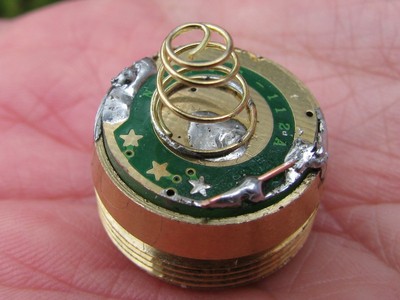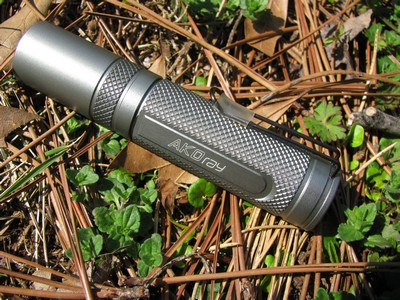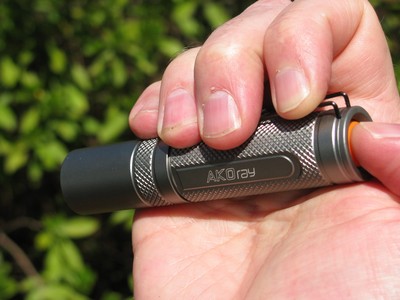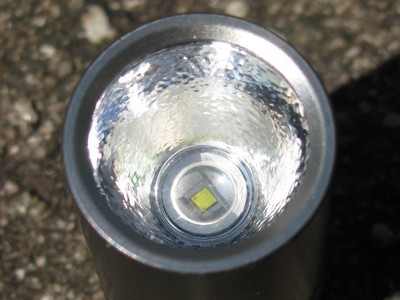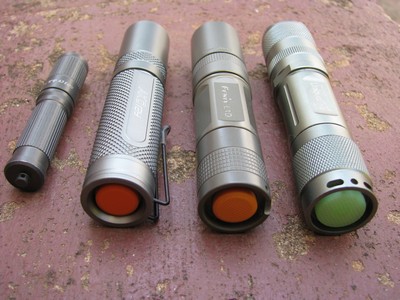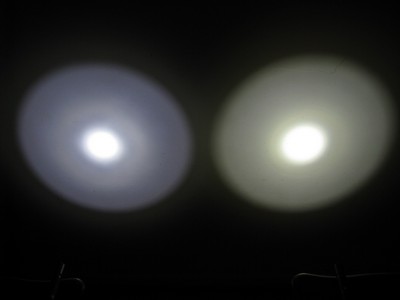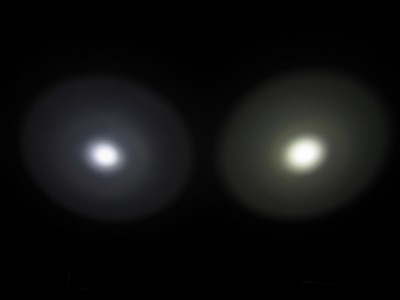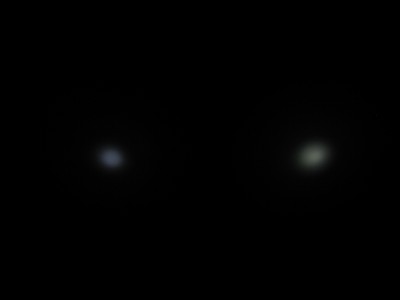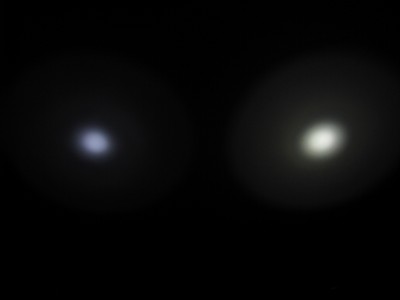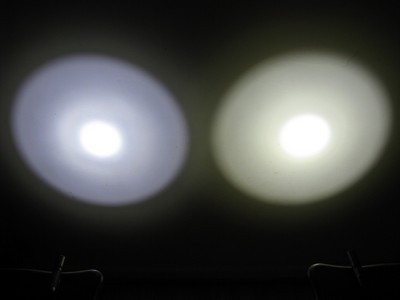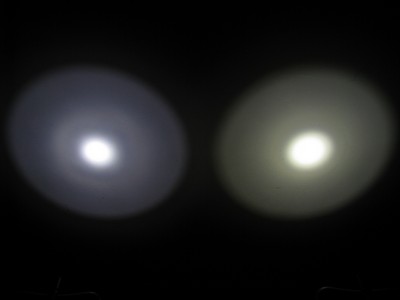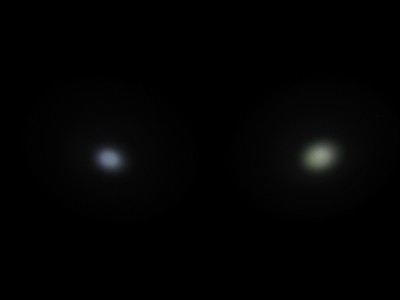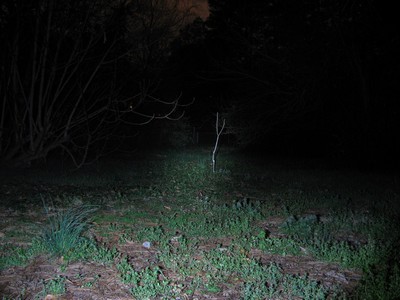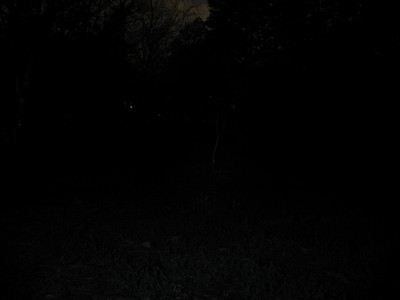Some lights are good for general purposes, some are really bright, some have a really good user interface, and lights like this one are more of a gimmick. They do one trick, in this case, it is able to go from a fairly faint flood of even light to a tiny beam of light that can be thrown at least a hundred yards by using an aspherical lens that can be moved with respect to the LED. At the tightest spot, you are actually seeing a representation of the LED itself, including the 3 strips of a XR-E LED (picture below is of the beam projected onto the ceiling; in real life you can see more detail including some of the bonding wires).
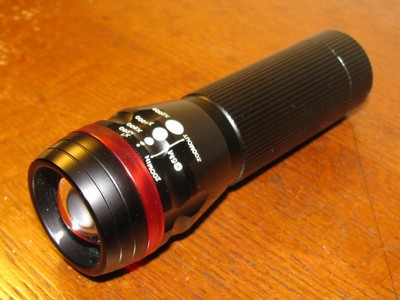
Summary:
| Battery: | 3xAAA |
| Switch: | Reverse Clicky |
| Modes: | 3 (no memory) |
| LED Type: | Cree XR-E Q5 |
| Lens: | Aspherical |
| Tailstands: | Mostly |
| Price Payed: | $13.98 |
| From: | eBay lovelycar8888
|
Pros:
- Great throw
- Bright
- 3 modes
- Uses NiMH batteries
- Quickly goes from flood to throw
Cons:
- Cheap construction
- Not real practical
- Bluish tint
Features / Value

There is a whole series of lights available on DealExtreme and elsewhere sometimes called the X2000 or C30. There are at least 3 battery configurations of the X2000 including CR123, 18650, and 3xAAA where the AAA batteries are put in a holder side-by-side and then the holder acts as one big 4.5V battery. These lights all have different overall lengths depending on the battery choice. All of the ones on DX advertise glass optics, but they all come with plastic optics according to reviews and comments. They also advertise Cree XR-E P4 LED's, but you can't really tell a P4 from a much brighter Q5 just by looking at it (at least the newer ones). One sold by KaiDomain and recently reviewed by Nautic here may be the best of both worlds, providing a holder 3xAAA batteries plus and extension tube allowing an 18650. A seller on eBay, lovelycar8888, sells a couple of versions of this light as well and promises a Q5 LED. However he also claims 220, 240, 260, or 280 lumens from his different offerings with various prices and there is no way a Q5 is going to produce 280 lumens. However, the light seems pretty bright and the LED looks just like the ones on my other Q5 and R2 lights. The tint is definitely cool white, distinctly bluish. It is one of my bluest lights, which I don't like. Part of the blue tint is from the LED, but holding the lens in front of another light I have, I noticed that some of the blue tint is coming from the lens.

I had a lot of questions when I bought the light. The first was did it have glass optics and the quick answer is no. The lens is plastic. That's a little disappointing. There is some definite chromatic aberration around the edges of the beam and I have to think glass could have reduced that some. Although the lens is set below the end of the front bezel (also plastic), it could still potentially be scratched.
I also wondered if I could use a lithium-ion battery in place of the battery holder. NiMH batteries are nominally 1.2V each, so three of them are 3.6V, which is the same a li-ion battery. And certainly the light can handle 1.5V alkalines, so no problem with a voltage up to 4.5V. The interior of the aluminum body tube is 23 mm in diameter. The battery holder itself is 54 mm long by 22 mm diameter. So a 26500 or a 18650 won't fit, but a 18500 would and would provide about twice the capacity as the 3xAAA battery holder with NiMH's (a 14500 would be about the same as the 3xAAA setup, so I don't see the point). The 18500 would need some kind of sleeve or else it would rattle around.
Although the tail switch protrudes very slightly, the light can still tailstand and it can go to candle mode if you unscrew the bezel (the green spot at the bottom is an artifact, not there in real life):

The light comes with a pretty weak looking lanyard, but the holster actually seems pretty decent, with a velcro closure flap and a substantial loop on back to slide onto a belt. If all of my lights came with those, I could wear them all at once!
The head slides forward and back. I had read that other versions of the light were very loose and people had added a big o-ring to provide some additional friction. While looser than a camera zoom lens, the feel is in the same neighborhood as that and will stay where you set it for the most part There is 7mm of travel as the light expands from 104mm to 111mm in length. For me the problem was more that if I hold it overhand with my thumb on the tail clicky (first picture below), part of my hand is on the head and when I press the clicky with my thumb, my hand makes the head slide. Because the light is so short, it works better held like a cigar if you are going to be clicking it on and off (second picture). If you're not worried about turning it on and off, a regular grip works fine and you can adjust the focus with the same hand (third picture).
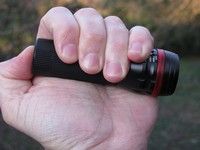


I bought the light from eBay after someone at CPF said they had gotten one from the same seller and liked it. The ones on DealExtreme all advertise a P4, so I was willing to pay a little more for a better chance of getting a Q5. The guy has an e-mail address in Taiwan, but ships from Los Angeles and he is quick! Within a couple of hours he had put it in the mail. I ordered it on Friday morning and it was on my doorstep all the way across the country via first class mail on Monday morning! He sells what look to be all the same light, calling them a lot of different things and giving them different lumen ratings and prices. The light was shipped in a box and the light itself was in a smaller box inside (no bubblewrap!) and in the holster (below), so it was well-protected. The inner box had no markings indicating a model number or the LED, just "MADE IN CHINA." I paid $7.99 plus $5.99 shipping, but he also has a Best Offer option and later on I noticed someone had bought what seemed to be the same light I had for only $6.00 (plus shipping). DX sells the C30 for $9.52 and the X2000 for $13.35 plus other versions using CR123 or 18650 batteries. I should also point out that I tried to order a version without the red glowing ring, but got it anyway. If you don't want that, you should probably write to the guy and see if he has that available.
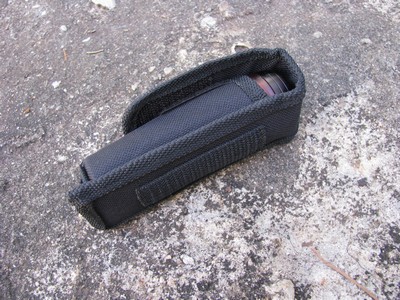
Build Quality
Build quality is okay. The entire head is made of plastic, including the plastic lens. The body and the tail seem to be aluminum, but it seems like sheet metal and the "anodizing" is more like a plastic coating. I may scratch it later and see. I have taken the bezel off (can't figure out how to take the whole head off) several times and the plastic threads are already showing some wear. You have to be very careful about threading them correctly or you risk doing some damage to them. The LED itself has some thin foil sheet around it and seems to be mounted underneath a substantial metal disk or washer. I can't get it apart any further to see what the LED is mounted to. Like I say, I couldn't get to the driver but I was able to pry it loose with tools from the tail end and I saw that it has some resistors and integrated circuits on it. Some early versions of the X2000 or C30 didn't have driver boards. Of course, having 3 modes pretty much means you have to have a driver. The tail clicky feels kind of cheap, but it works fine.
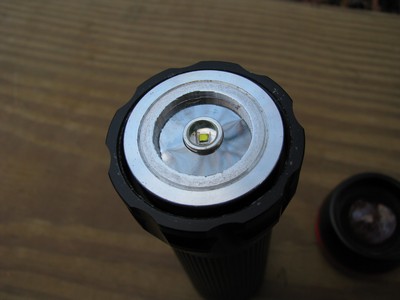
The light comes with a red transluscent plastic ring in the bezel that catches some light and glows. While that is a neat idea, I don't really want any light coming back to me like that, especially since I usually hold it up close to my face. In fact, I made sure I ordered an item that didn't look like it had the red ring, but I got it anyway. Some electrical tape should fix it.
Battery Life
The light barely gets warm, so I'm not sure how great the heat sinking is, or if the LED isn't being driven that hard. I can't measure lumens or even lux, so the best I can do is take readings from time to time of the current and voltage. In this case I am measuring the voltage of the 3 AAA's in their holder together, so the battery voltage would really be a third of this. I am using 800mAh AAA white-topped precharged Duracell batteries ("Duraloops"). The brightness seemed to drop quite a bit at around an hour. The batteries were pretty much depleted and the light was officially dim by 90 minutes.
| Time (hr:min) | Voltage | High (mA) | Medium (mA) |
|---|
| 0:00 | 4.24 | 870 | 170 |
| 0:15 | 3.84 | 640 | 120 |
| 0:30 | 3.79 | 650 | 120 |
| 0:45 | 3.75 | 610 | 110 |
| 1:00 | 3.67 | 530 | 100 |
| 1:15 | 3.48 | 380 | 70 |
| 1:30 | 2.95 | 100 | 30 |
Light Output
The light has a Medium and High level, always coming on in Medium (it's not really a Low). This took some getting used to because Medium isn't too bad, but the light performs a lot better on High. It's probably good to be able to back off a little and I'm not sure a true low is needed since full flood on Medium is faint enough for close up use.
It is very hard for me to gauge the overall output of the light. The seller said it is a Q5 bin Cree XR-E, so it should be cranking out 180 lumens or so. Here are some indoor pictures just to give you an idea of how it compares to my Fenix L2D which is powered by 2 AA batteries and also has a Cree XR-E Q5 LED.
Indoor wall shots on High
On High with full flood at 1/25th second with both lights 50cm from the wall with the ZY-30 on the left and the Fenix L2D on the right. All of the pictures in this review can be clicked on to open an image twice that size. You can see that the Fenix has a wider spill, but the ZY-30 has a more even flood (you can also sort of see the red glowing bezel in the lower left):
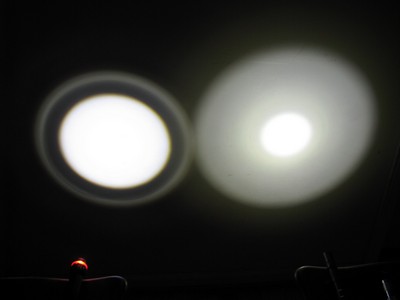
Again at 1/100th second exposure:
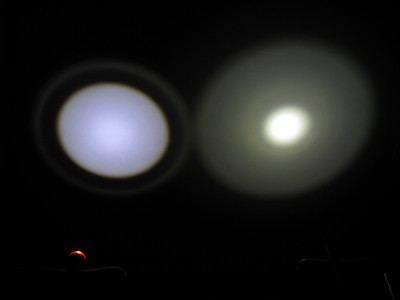
And again at 1/1600th second:

Now a series with the lens at about halfway between flood and throw. At this setting the hotspot on both lights are about the same intensity. At 1/25 second:
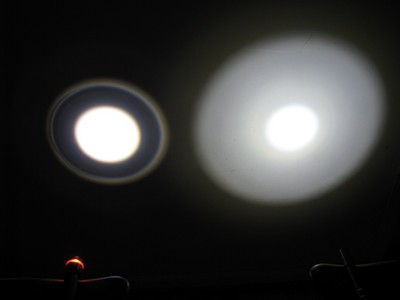
And at 1/100th second:

At 1/1600th second:
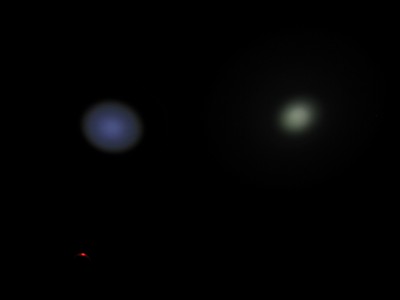
Finally, a series with the light on maximum throw, with a square beam of the emitter. At a close range like this, the emitter isn't a clear and you can't see the strips on the LED, but anything further than this, even outside at a distance, you can see the lines of the strips when the light is moving:
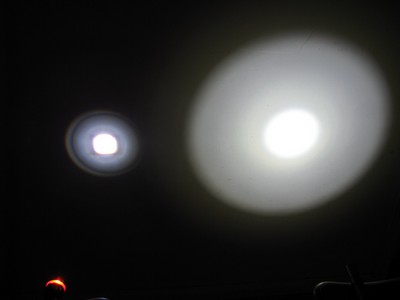
At 1/100th second:

And at 1/1600th second. It's still pretty intense:
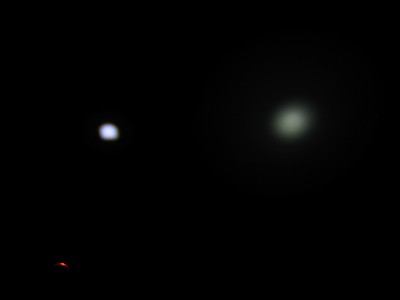
I took shots with both lights on Medium and can post that if you want, but this seems like a lot of pictures already.
Outdoor shots on High
Well, you don't use a thrower indoors, that's for sure. So I'll just jump right to how this light performs on throw. But first, here is a control shot and then a reference shot. All of these are taken with a 4-second exposure to get something close to what it looks like in real life. First, the control shot (yes, it is dark):

Now here is my best thrower, the Ultrafire MCU WF-1200L with a SSC P7 and a big head to focus the light, powered by two 18650 batteries. This is a lot of light, both in terms of spill and the hot spot. The forked stick is about 25' away and the beam is aimed at the fence posts in the middle of the picture which are about 120' away:
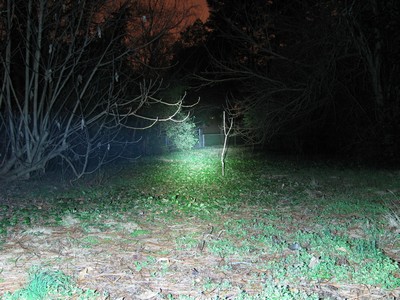
Now here is the ZY-30 on high and maximum throw. The fence posts are really lit up and they aren't all that reflective. Hardly any spill to speak of. I would say this light is very effective up to 100 yards and starts becoming much less useful at 200 yards.
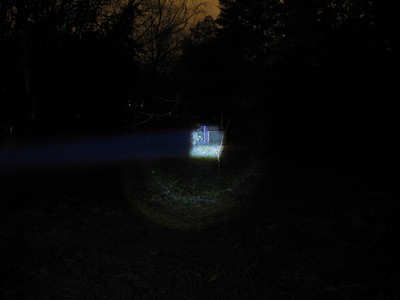
Here are pictures of the fence at original size side-by-side for comparison (can't click to enlarge these). Here I think the ZY-30 loses out, but the WF-1200L has a greenish tint that helps some:

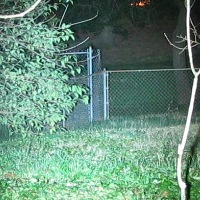
That's not an entirely fair comparison since the Ultrafire puts out up to 600 lumens, so here is another good thrower, the Ultrafire WF-504B with a XR-E R2 drop-in. The R2 is a little higher bin than the Q5, but in the same neighborhood. There's no question the ZY-30 wins out here:

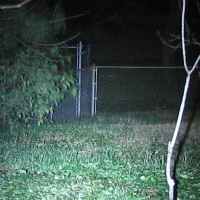
Now here is the ZY-30 at about 75% towards throw, which produces a fairly tight, round spot:
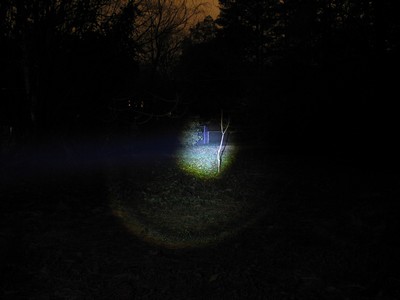
Now at about 50% throw. You can see the ugly outer ring and the chromatic aberration around the edges:
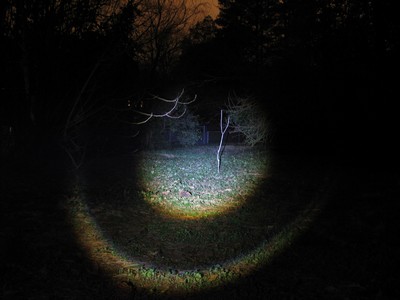
Now backed out all the way to flood. It's a lot of light, but it drops off pretty fast. You can barely see the fence posts and the stick is at about the edge of its useful range:
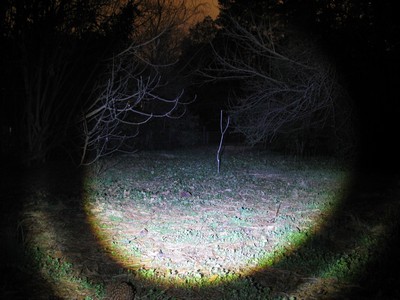
Outdoor shots on Medium
Now here is the light on medium, the same series as above. Medium seems to be about a third of High, but I'll have a better idea when I take current readings later. Medium uses PWM which isn't too bad, but I'm not as sensitive as some. I will say that it was very hard catching any light at all on 1/1600th because of the PWM. Anyway, here are the outdoor shots on Medium:
100% throw:

75% throw:
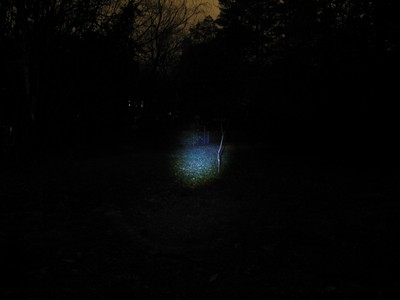
50% throw:
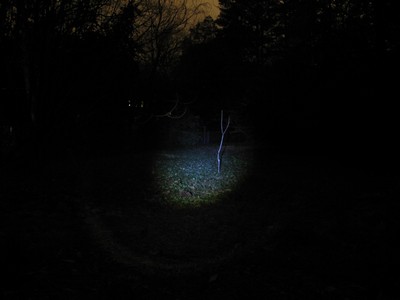
Flood:
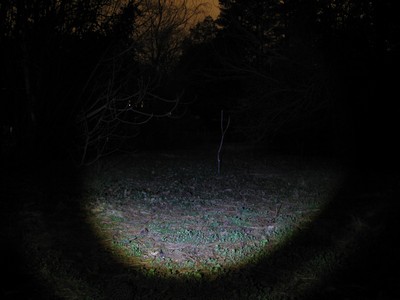
Summary
This is a fun toy, but the throw could be really useful for spotting objects at about 100 yards. It is not a light I would carry regularly though. I wish I knew what I was really getting in terms of the LED or even the lumen output, but the description on DealExtreme and eBay are both full of conflicting or just plain bad information.

